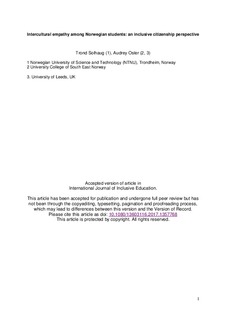Intercultural empathy among Norwegian students: an inclusive citizenship perspective
Journal article, Peer reviewed
Submitted version
Permanent lenke
http://hdl.handle.net/11250/2580724Utgivelsesdato
2017Metadata
Vis full innførselSamlinger
Originalversjon
International Journal of Inclusive Education. 2017, 22 (1), 89-110. 10.1080/13603116.2017.1357768Sammendrag
In recent decades, Norwegian schools have experienced increased cultural diversification among students. Growing heterogeneity in origin and culture may enhance the risk of student marginalisation, segregation and exclusion. In response to these challenges, this paper examines students’ intercultural empathy and, particularly, how schools can develop their intergroup empathy to support social inclusion. Theoretically, we applied an inclusive citizenship perspective. The study draws primarily on quantitative data gathered from paper questionnaires collected from 1006 students in two upper secondary schools and three lower secondary schools. We explored the antecedents of intercultural empathy among the students using regression analyses. First, we found that there are substantial differences between the scores of boys and girls on intercultural empathy. Second, we found that information on culture and diversity was a predictor of certain aspects of intercultural empathy. Third, a variety of school variables were applied to explore possible ways to support student intercultural empathy, which showed moderate associations with intercultural empathy. Fourth, variables measuring students’ perceptions of human rights implementation in school were also moderately associated with aspects of intercultural empathy. The results and their implications for teaching are discussed.
